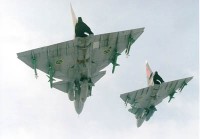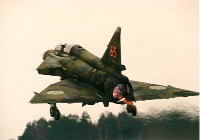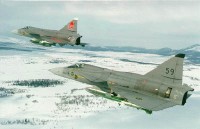Global Aircraft -- Saab 37 Viggen
|
Aviation Center
US Attack
US Bombers
US Cargo
US Fighters
US Helicopters
US Patrol/Pursuit
US Reconnaissance
US Tankers
US Trainers
US UAV's
US X Planes
Orbiter Vehicles
WWI Aircraft
WWII Aircraft
Airbus
Antonov
Boeing
Dassault
Ilyushin
Kamov
MiG
Mil
Saab
Sukhoi
Tupolev
Yakovlev
Joint/Rest of World
Entertainment Center
Members Center
New Technologies
Contact Us
Extra Navigation
GAC Engine
Saab 37 Viggen Specifications
Saab 37 Viggen Features
The Viggen was powered by a single Svenska Flygmotor RM 8 turbofan. (license-built variant of the Pratt & Whitney JT8D engine that powered commercial airliners of the 1960s) with an afterburner added for the Viggen. The engine also incorporated a thrust-reverser to use during landings and land manoeuvres, which, combined with the aircraft having flight capabilities approaching a limited STOL-like performance, enabled operations from 500 m airstrips with minimal support. The thrust reverser could be pre-selected in the air to engage when the nose-wheel strut was compressed after touchdown. Only the Viggen and the Panavia Tornado featured both afterburners and thrust-reversers.
The requirements from the Swedish Air Force dictated Mach 2 capability at high altitude and Mach 1 at low altitude. At the same time, short-field takeoff and landing performance was also required. Since the Viggen was developed initially as an attack aircraft instead of an interceptor (the Saab 35 Draken fulfilled this role), some emphasis was given to low fuel consumption at high subsonic speeds at low level for good range. With turbofan engines just emerging and indicating better fuel economy for cruise than turbojet engines, the former was favoured, since the latter were mainly limited by metallurgy development resulting from limitations in turbine temperature. Mechanical simplicity was also favoured, so the air intakes were simple D-section types with boundary layer splitter plates, while the fixed inlet had no adjustable geometry for improved pressure recovery. The disadvantage was that the required engine would be very large. In fact, at the time of introduction, it was the second largest fighter engine, with a length of 6.1 m and 1.35 m diameter. Only the Tumansky R-15 was bigger. Saab had originally wanted the Pratt & Whitney TF30 as the Viggen powerplant. Since the engine was not finished in 1962 when the airframe vs. engine design size needed to be frozen, the civilian variant of the TF30 - the JT8D was chosen as the basis for a Volvo Aero modification instead. The RM 8 became the second operational afterburning turbofan in the world, and also the first equipped with a thrust reverser. It had a bypass ratio of around 1.07:1 in the RM8A, which reduced to 0.97:1 in the RM8B. The AJ, SF, SH and SK 37 models of the Viggen had the first version of the RM 8A engine with uprated internal components from the JT8D that it was based on. Thrust was 65.6 kN dry and 115.6 kN with afterburner.[8] For the JA 37, the RM 8A was modified to an 8B by replacing one LP compressor stage with a fan stage and improved combustor, turbine and afterburner. Thrust is 72.1 kN dry and 125.0 kN with afterburner. The engine was started via a small gas turbine, itself started by an electric motor. Standby power and cooling air for onboard avionics were supplied via an external cart. An internal battery permitted start of the starter turbine and main engine in absence of the standby power cart. With the performance requirements to a large extent dictating the choice of the engine, the airframe turned out to be quite bulky compared to contemporary slimmer designs with turbojet engines. The first prototypes had a straight midsection fuselage that was later improved with a "hump" on the dorsal spine for reduced drag according to the area rule. The wing had the shape of a double delta with a dogtooth added to improve longitudinal stability when carrying external stores.[9] Each dogtooth was also used as a fairing for a radar warning receiver (RWR) antenna. The canards were positioned behind the inlets and placed slightly higher than the main wing, but were not movable as control surfaces. The purpose of the canard wings were to act as vortex generators for the main wing and therefore provide more lift. An added benefit was that they also improved roll stability in the transonic region around Mach 0.9. The canard flaps were deployed in conjunction with the landing gear to provide even more lift for takeoff and landing. To withstand the stresses of no-flare landings, Saab made extensive use of titanium in the construction of the Viggen, especially in the fuselage, and incorporated an unusual arrangement for the main landing gear, in which the two wheels on each leg were placed in tandem. While such a layout is common in airliners and cargo aircraft, it is rare in fighters, but allows stowage in a thinner wing. The tall single vertical stabilizer (45 degrees sweepback on the leading edge) was foldable to make it easier to store in hangars. After prototype testing of the SK variant, reduced longitudinal stability was discovered. To correct this, the vertical stabilizer was extended 10 cm and the pitot tube was moved from the top of the fin leading edge to about midpoint where a sawtooth was also incorporated. The JA model later used the same improvements. The six tanks in the fuselage and wings held approximately 5,000 litres of fuel with an additional 1,500 litres in an external drop tank. The specific fuel consumption was only 0.63 for cruise speeds (fuel consumption was rated 18 mg/Ns dry and 71 with afterburner. The Viggen's consumption was around 15 kg/sec at maximum afterburner, which meant that the internal fuel was exhausted in just seven minutes due to the relative inefficiency of the turbofan over a turbojet at full afterburner. Performance comparisons with other aircraft from the same age are however slightly difficult, since no other fighter or attack aircraft aside from the Harrier and Yak-38 were designed for STOL or VTOL capability. In the early 1960s, it was decided that the Viggen should be a single seat aircraft. A digital central computer and a head-up display replaced the human navigator. This computer, called CK37 (centralkalkylator 37), was the world's first airborne computer to use integrated circuits.It utilized the STRIL 60 system to be linked with the Swedish defence systems. The main sensor was an Ericsson PS-37 X-band monopulse radar with several functions: air-to-ground and air-to-air telemetry and cartography. A Honeywell radar altimeter with transmitter and receiver in the canard wings was used to assist low altitude flight. A Decca Type 72 doppler navigation radar and a series of other electronic sub-systems were also provided. A novel landing-aid device - TILS (Tactical Instrument Landing System) made by Cutler-Hammer AIL was used to improve landing accuracy down to 30 m from the threshold on the short highway airbase system.ECM consisted of SATT RWR system in the wings and the tail, an optional Ericsson Erijammer pod and BOZ-100 chaff/flare pod. In total, the electronics weighed 600 kg which was a substantial amount for a single-engine, late 1960s fighter. The SK 37 trainer omitted the radar and CK37 navigational computer, navigating only using the Decca system and later DME. The radar warning receiver electronics were also removed. Initially, only a single reconnaissance (S) variant was considered, but fitting cameras as well as a radar proved to be impossible. The SH 37 maritime strike and reconnaissance variant was very similar to the AJ 37 and differed mainly in a maritime optimized PS-371/A radar with longer range and cockpit camera and tape recorder for mission analysis. "Red Baron" and LOROP camera pods were usually carried on the fuselage pylons. The centerline fuel tank was converted for a short period of time to a camera pod with two Recon/Optical CA-200 1676 mm cameras. In addition to the reconnaissance equipment, the SH 37 could also use all weapons for the AJ 37. For the photographic SF version, the radar in the nose was omitted in favour of one SKa 24 57 mm, three SKa 24C 120 mm and two SKa 31 600 mm photographic cameras as well as one VKa 702 Infrared linescan camera. The "Red Baron" and LOROP camera pods could also be carried on the fuselage pylons. The avionics suite of the JA was a major improvement over the other variants designed a decade earlier. The onboard computer was a Singer-Kearfott SKC-2037 built under license by Saab as CD 107, a Garrett AiResearch LD-5 air data computer (also used in the F-14 Tomcat), a Saab-Honeywell SA07 automatic flight control systems (which was one of the first digital variants to enter production) and a KTL-70L inertial navigation system. In the cockpit, several dial-indicator instruments were replaced by two CRT displays; one target indicator MI (sw: MålIndikator) in the center and one tactical moving- and rotating map indicator TI (sw: Taktisk Indikator) to the right while the head-up display SI (sw: SiktlinjesIndikator - line-of-sight indicator) was retained. The radar on the JA 37 was upgraded to a multi-mode, pulse-Doppler Ericsson PS-46/A unit more optimized for the fighter/interceptor role. It sported lookdown/shootdown capability, range up to 48 km, continuous-wave illumination for the Skyflash missiles as well as the ability to track two targets while scanning. The MTBF was reported as 100 hours, a very high reliability level for that generation of avionics systems. In 1992, an upgrade program of some of the AJ/SF/SH (with least hours on the airframe) to AJS/AJSF/AJSH was initiated because of delays of the new JAS 39 Gripen. The modifications were not too extensive and consisted to the major part of a new Ericsson computer processor system, MIL-STD-1553B databus and MIL-STD-1760 stores interface system to carry the Rb 15F anti-ship missile and DWS 39 Mjölner submunitions dispenser. An upgraded radar warning receiver system with recording capability as well as a mission planning system via a portable cartridge were also implemented. The original PS-37/A radar from the AJ 37 was upgraded to the PS-371/A (from the SH 37) allowing the new AJS 37 to perform radar reconnaissance missions. No airframe- and very minor cockpit modifications were made. The JA 37 was continuously upgraded throughout its lifetime. In 1985, the "fighter link" went into service, permitting encrypted data communication between four fighters and ground radar based fighter command. This enabled one fighter to "paint" an airborne enemy with guidance radar for the Skyflash missiles of the three other fighters in a group while they had their search and guidance radar switched off. This system was operational ten years before any other country's. The autopilot was also slaved to the radar control to obtain better precision firing the cannon. In 1990, the PS-46/A was upgraded with higher resistance to jamming and the ability to track several targets at the same time. In 1993, the ability to generate virtual targets in the radar reduced the cost of flying aggressors for training. Between 1992 and 1997, a major avionics upgrade program to the JA was implemented, given the new designation JA 37D. It consisted of an Ericsson CD207 mission computer, an ANP-37 stores management computer, linked via dual MIL-STD-1553B databuses permitting use of the Rb 99 AMRAAM. In the cockpit, a TI 327 color tactical moving-map display (originally intended for the Gripen) and a Synthetic Attitude Heading Reference System were installed. The ECM and ECCM suite were enhanced with improved electronics, upgraded radar warning receivers, a new Ericsson U95 jammer pod as well as the ability to carry BOY-401 chaff/flare dispensers on a separate location from the weapon pylons. Between 1998 and 2000, the conversion of ten Sk 37 trainers to Sk 37E electronic aggressors was completed. The fairly substantial upgrade package consisted of the nose-radome mounted G24 jammer inherited from the decommissioned J 32E Lansen, U22/A jammer- and KB chaff/flare pods and radar warning receivers from the AJS 37 and a new U95 jammer pod all linked together with the MIL-STD-1553B databus. The rear cockpit for the Electronic Warfare Officer was improved with new displays and controls while retaining the ability to convert back to the original flight training role. The displays in the original cockpit were all of the traditional analogue/mechanical type with the exception of an electronic HUD which could be used as a precision landing aid. Original layout drawings show the forward display area dominated by a central large Horizontal Situation Indicator (HSI) with its integral altitude warning light. To the left were the attitude indicator, altimeter and airspeed indicator / MACH displays and to the right, twelve smaller displays including a clock, g-meter, destination indicator, standby instruments, R.P.M. indicator, distance indicator, EPR indicator and fuel indicator. The ejection seat was the Raketstol 37 and was the last Saab designed seat in service. A derivative of the Saab 105 trainer seat, the seat was optimized for low altitude, high speed ejections. Low speed capability was limited to speeds above 75 km/h on the runway. The seat was angled back by 19 degrees to help counter g-forces in flight. The pilot flew with a centre stick and left side throttle. The hands-on-throttle%u2013and-stick HOTAS controls included trim, autopilot disengage, event marker and trigger (on the stick) and ECM switch and missile seeker un-cage (on the throttle). Adjacent to the throttle was a separate radar joystick. There were dedicated warning caption panels each side of the pilot's legs. On the right console panel were numerous dedicated controls and indicators, including weapons and missile controls, nav panel, oxygen on/off, windshield de-fogging, IFF control, lighting controls. Situated on the left console panel were radar controls, canopy handle, landing gear handle, radio controls and the cabin pressure indicator. A weapons load of up to 7,000 kg could be accommodated on seven hardpoints; one centerline pylon, two fuselage pylons, two inner and two outer wing pylons. The centerline pylon was the only wet pylon and was usually occupied by an external fuel tank. The outboard wing pylons were never used in peacetime since aerodynamic flutter loads would structurally fatigue the wing.
Saab 37 Viggen Background
The Viggen was initially developed as a replacement for the Saab 32 Lansen in the attack role and later the Saab 35 Draken as a fighter.The first studies were carried out between 1952 and 1957 involving the legendary Finnish aircraft designer Aarne Lakomaa. Several different concepts were studied involving both single- and twin engines and also with separate lift engines, both simple and double delta wings and also with canard wings. Even VTOL designs were considered.
The aim was to produce a robust aircraft with good short-runway performance that could be operated from numerous specially prepared roads and highways to reduce the vulnerability to attack in the event of war. Other requirements included supersonic ability at low level, Mach 2 performance at altitude, and the ability to make short landings at low angles of attack (to avoid damaging improvised runways). The aircraft was also designed from the beginning to be easy to repair and service, even for personnel without much training. To meet these design goals, Saab selected a radical configuration: a conventional delta wing with small, high-set canard wings. Canards have since become common in fighter aircraft, notably with the Eurofighter Typhoon and the IAI Kfir, but mainly for agility reasons rather than STOL capabilities. The final proposal was presented and accepted on 28 September 1962.Construction started in 1964, with a first prototype maiden flight on 8 February 1967. In 1960, the U.S. National Security Council, led by President Eisenhower, formulated a military security guarantee for Sweden. The U.S. promised to help Sweden militarily in case of a Soviet attack against Sweden and both countries signed a military-technology agreement. In what was known as the "37-annex", Sweden was allowed access to advanced U.S. aeronautical technology which made it possible to design and produce the Saab 37 Viggen much faster and cheaper than would otherwise have been possible. According to the doctoral research of Nils Bruzelius at the Swedish National Defence College, the reason for this officially unexplained U.S. support was the need to protect U.S. Polaris submarines deployed just outside the Swedish west coast against the threat of Soviet anti-submarine aircraft. | ||||||||||||||||||||||||||||||||||||||



